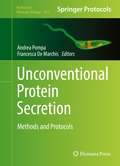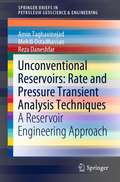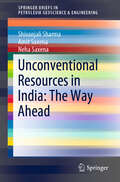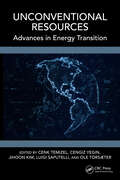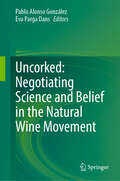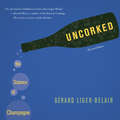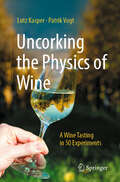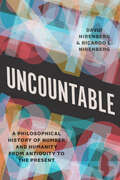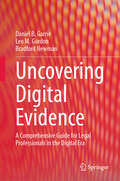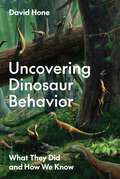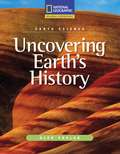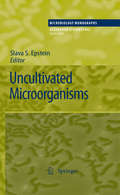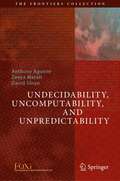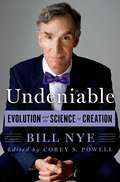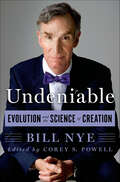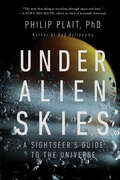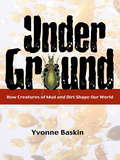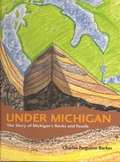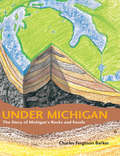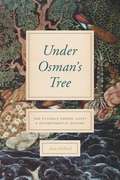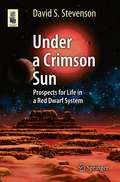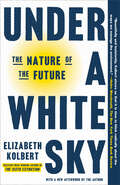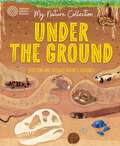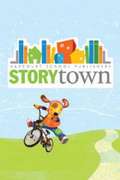- Table View
- List View
Unconventional Protein Secretion
by Andrea Pompa Francesca De MarchisThis volume presents relevantbackground information to understanding the molecular basis governingunconventional protein secretion (UPS), and in particular explores the latesttechniques and protocols that have been successfully applied for the study ofthis topic. Detailed chapters include an overview of conventional andunconventional secretory pathways along with multidisciplinary approaches andmethods used for UPS analysis in different organisms. Written in the highly successful Methods inMolecular Biology series format, chapters include introductions to theirrespective topics, lists of the necessary materials and reagents, step-by-step,readily reproducible laboratory protocols, and tips on troubleshooting andavoiding known pitfalls. Authoritative and cutting-edge, UnconventionalProtein Secretion: Methods and Protocols will be usefulfor all interested in the secretory pathway field as well as applications incell biology, cell development, biomedical research, and healthcare.
Unconventional Reservoirs: A Reservoir Engineering Approach (SpringerBriefs in Petroleum Geoscience & Engineering)
by Mehdi Ostadhassan Amin Taghavinejad Reza DaneshfarThis book provides a succinct overview on the application of rate and pressure transient analysis in unconventional petroleum reservoirs. It begins by introducing unconventional reservoirs, including production challenges, and continues to explore the potential benefits of rate and pressure analysis methods. Rate transient analysis (RTA) and pressure transient analysis (PTA) are techniques for evaluating petroleum reservoir properties such as permeability, original hydrocarbon in-place, and hydrocarbon recovery using dynamic data. The brief introduces, describes and classifies both techniques, focusing on the application to shale and tight reservoirs. Authors have used illustrations, schematic views, and mathematical formulations and code programs to clearly explain application of RTA and PTA in complex petroleum systems. This brief is of an interest to academics, reservoir engineers and graduate students.
Unconventional Resources in India: The Way Ahead (SpringerBriefs in Petroleum Geoscience & Engineering)
by Shivanjali Sharma Amit Saxena Neha SaxenaThis book addresses unconventional hydrocarbon resources in India and the prospects for their exploitation. Each chapter focuses on a particular unconventional resource, including gas hydrates, coal bed methane and shale, while the book as a whole takes into account the government’s projections concerning these resources. The book provides readers with essential information on the nation’s energy requirements, methods of exploiting its available unconventional resources, and their contribution to meeting India’s energy requirements. It also addresses the various geological conditions that are necessary for the exploration of these resources, and enables readers to understand the challenges that need to be overcome. Its logical, clearly structured chapters make the book an ideal starting point for readers interested in unconventional energy resources. It will especially benefit undergraduate and graduate students in the field of Energy Engineering, as well as academic researchers and industry professionals seeking an overview of the status quo of unconventional hydrocarbon resources in India.
Unconventional Resources: Advances in Energy Transition
by Jihoon Kim Luigi Saputelli Cenk Temizel Ole Torsæter Cengiz YeginThe oil and gas sector is a vital player in the energy transition. With their vast resource potential, unconventional shale plays will be an essential part in enabling this change. Unconventional Resources serves as a comprehensive reference covering the latest technologies, methodologies, and applications of unconventional shale resources in the oil and gas industry, and their role in the evolution of the sector's energy transition.This book: Offers an overview of geophysics, geology, and reservoir characterization in unconventional resources Discusses drilling, well stimulation and completion, production engineering, and artificial lift Covers reservoir management and surveillance, recovery enhancement, production forecasting, and surface facilities and testing Details technical and technological advances, including machine learning, AI, data analytics, and Industry 4.0 Explores the latest methods/workflows in performance analysis in unconventional plays Employs integrated and hybrid approaches to the energy transition The book provides surface and subsurface technical professionals in the oil and gas industry a thorough overview of unconventionals along with the integrated/hybrid applications that will enable them to stay current with the industry's transition.
Unconventional Water Resources
by Vladimir Smakhtin Manzoor Qadir Sasha Koo-Oshima Edeltraud GuentherThe world is faced with a growing number of complex and interconnected challenges. Water is among the top 5 global risks in terms of impacts, which would be far reaching beyond socio-economic challenges, impacting livelihoods and wellbeing of the people.As freshwater resources and population densities are unevenly distributed across the world, some regions and countries are already water scarce. Water scarcity is expected to intensify in regions like the Middle East and North Africa (MENA), which has 6% of the global population, but only 1% of the world’s freshwater resources. Climate change adds to this complexity as it is leading to rainfall uncertainty and extended droughts periods, mostly in arid areas.Increasing water scarcity is now recognized as a major cause of conflict, social unrest and migration and at the same time water is increasingly considered as an instrument for international cooperation to achieve sustainable development. Tapping and assessing sustainably every available option in water-scarce areas is needed as pressure continues to build on limited water resources.The stark fact is that conventional water provisioning approaches relying on snowfall, rainfall and river runoff are not enough to meet growing freshwater demand in water-scarce areas. Water-scarce countries need a radical re-think of water resource planning and management that includes the creative exploitation of a growing set of viable but unconventional water resources for food production, livelihoods, ecosystems, climate change adaption, and sustainable development. Unconventional water resources are generated as a by-product of specialized processes; need suitable pre-use treatment; require pertinent on-farm management when used for irrigation; or result from a special technology to collect/access water.
Uncorked: Negotiating Science and Belief in the Natural Wine Movement
by Pablo Alonso González Eva Parga DansNatural wine is a captivating and rapidly evolving phenomenon in the world of viticulture and winemaking. This movement, characterized by minimal intervention, low or no chemical additives, and a focus on terroir-driven expressions of grapes, has ignited a passionate following among wine enthusiasts, sommeliers, and eco-conscious consumers. It's more than just a beverage; it embodies a philosophy that aligns with contemporary sustainability and wellness trends. Though natural wine enthusiasts have produced ample coverage of the natural wine movement in books, essays and films, academics have lagged behind in their examination of this global phenomenon. In Uncorked: Negotiating Science and Belief in the Natural Wine Movement, scholarly discussion reaches across disciplines to offer valuable insights for researchers, producers, wine enthusiasts and anyone with an interest in this movement. Exploring the relevance of natural wine offers a unique lens through which to examine the intersection of tradition, innovation, environmental stewardship, and the evolving tastes of modern consumers. Through the stories of the winemakers, the science behind natural fermentation, and the cultural and historical context, this book aims to provide a comprehensive look at how this movement is shaping the future of wine and our relationship with the natural world. Each essay from a thought leader in their respective field delves deep into the historical, ecological, and sociocultural dimensions of natural winemaking, shedding light on its ancient roots, ecological practices, and the philosophical underpinnings that drive the movement. Discussions of regulatory and consumer aspects will also elucidate the practical considerations of making and selling natural wine. Uncorked: Negotiating Science and Belief in the Natural Wine Movement is a groundbreaking edited book that offers a comprehensive and scholarly exploration ofthe world of natural wine. This interdisciplinary volume brings together leading experts in fields ranging from enology and sensory studies to anthropology and philosophy, creating a rich tapestry of insights into the production, consumption, and cultural significance of natural wine. Academics, winemakers and wine enthusiasts alike will be illuminated by this volume.
Uncorked: The Science of Champagne - Revised Edition
by Gérard Liger-BelairThe spectacular science behind champagne's effervescenceUncorked quenches our curiosity about the inner workings of one of the world's most prized beverages. Esteemed for its freshness, vitality, and sensuality, champagne is a wine of great complexity. Mysteries aplenty gush forth with the popping of that cork. Just what is that fizz? Can you judge champagne quality by how big the bubbles are, how long they last, or how they behave before they fade? And why does serving champagne in a long-stemmed flute prolong its chill and effervescence? Through lively prose and a wealth of state-of-the-art photos, this revised edition of Uncorked unlocks the door to what champagne is all about.Providing an unprecedented close-up view of the beauty in the bubbles, Gérard Liger-Belair presents images that look surprisingly like lovely flowers, geometric patterns, even galaxies as the bubbles rise through the glass and burst forth on the surface. He illustrates how bubbles form not on the glass itself but are "born" out of debris stuck on the glass wall, how they rise, and how they pop. Offering a colorful history of champagne, Liger-Belair tells us how it is made and he asks if global warming could spell champagne's demise. In a brand-new afterword, he updates the reader on new developments in the world of bubble science and delves even more deeply into the processes that give champagne its unique and beautiful character.Bubbly may tickle the nose, but Uncorked tackles what the nose and the naked eye cannot—the spectacular science that gives champagne its charm and champagne drinkers immeasurable pleasure.
Uncorking the Physics of Wine: A Wine Tasting in 50 Experiments
by Patrik Vogt Lutz KasperA still sealed wine bottle, a corkscrew, and a smartphone are undoubtedly a promising combination. Notify good friends with one device and extract the cork from the bottle with the other – what more could one want? Perhaps, in addition to quenching the thirst, the "mind" also craves satisfaction!With this book, you practice your physics mindfulness during the enjoyment of wine: you learn how to determine the speed of sound with the characteristic pop sound when opening the bottle, how to properly decant wine, what peculiarities red wine shows in laser light, and what Pythagoras has to do with wine.Uncorking the Physics of Wine creates the wonderful connection between science and wine. An inspiring non-fiction book – with experiments to participate in and replicate, or simply to savor. The authorsLutz Kasper studied physics and mathematics at University of Hannover to become a teacher and completed his doctorate in physics education at the University of Potsdam. He has been a professor of physics and physics education at University of Education Schwäbisch Gmünd since 2011. In recent years, he also has worked as an invited visiting professor in the physics department of Grand Valley State University (MI) and at the Taraz Pedagogical University (Kazakhstan).Patrik Vogt studied physics and mathematics on a teaching degree at the University of Koblenz-Landau and was a research assistant and secondary school teacher at various schools and universities in Germany until 2019. Since then, he is head of the department "Media Education, Mathematics, Natural Sciences, Music, Philosophy" at the ILF in Mainz, Germany. His work focuses on the possible uses of mobile devices in physics lessons, especially as a measuring instrument, task culture and the physics of everyday life.
Uncountable: A Philosophical History of Number and Humanity from Antiquity to the Present
by David Nirenberg Ricardo L. NirenbergRanging from math to literature to philosophy, Uncountable explains how numbers triumphed as the basis of knowledge—and compromise our sense of humanity. Our knowledge of mathematics has structured much of what we think we know about ourselves as individuals and communities, shaping our psychologies, sociologies, and economies. In pursuit of a more predictable and more controllable cosmos, we have extended mathematical insights and methods to more and more aspects of the world. Today those powers are greater than ever, as computation is applied to virtually every aspect of human activity. Yet, in the process, are we losing sight of the human? When we apply mathematics so broadly, what do we gain and what do we lose, and at what risk to humanity? These are the questions that David and Ricardo L. Nirenberg ask in Uncountable, a provocative account of how numerical relations became the cornerstone of human claims to knowledge, truth, and certainty. There is a limit to these number-based claims, they argue, which they set out to explore. The Nirenbergs, father and son, bring together their backgrounds in math, history, literature, religion, and philosophy, interweaving scientific experiments with readings of poems, setting crises in mathematics alongside world wars, and putting medieval Muslim and Buddhist philosophers in conversation with Einstein, Schrödinger, and other giants of modern physics. The result is a powerful lesson in what counts as knowledge and its deepest implications for how we live our lives.
Uncovering Digital Evidence: A Comprehensive Guide for Legal Professionals in the Digital Era
by Daniel B. Garrie Leo M. Gordon Bradford NewmanThis book serves as a comprehensive guide for legal practitioners, providing a primer on digital forensic evidence and essential technological concepts. Through real-world examples, this book offers a systematic overview of methodologies and best practices in collecting, preserving, and analyzing digital evidence. Grounded in legal precedent, the following chapters explain how digital evidence fits within existing legal frameworks, addressing questions of admissibility, authenticity, and ethical considerations. The aim of this book is to bridge the digital knowledge gap that often hinders the legal process, empowering readers with the tools needed for effective engagement in tech-related legal matters. Ultimately, the book equips judges, lawyers, investigators, and jurists with the knowledge and skills to navigate the digital dimensions of legal cases proficiently.
Uncovering Dinosaur Behavior: What They Did and How We Know
by David HoneHow scientists are unravelling one of the most tantalizing questions in paleontologyOur understanding of dinosaur behavior has long been hampered by the inevitable lack of evidence from animals that went extinct more than sixty-five million years ago and whose daily behaviors are rarely reflected by the fossil record. Today, with the discovery of new specimens and the development of new and cutting-edge techniques, paleontologists are making major advances in reconstructing how dinosaurs lived and acted. Uncovering Dinosaur Behavior provides an unparalleled look at this emerging field of science, presenting the latest findings on dinosaur behavior and explaining how researchers interpret the often minimal and even conflicting information available to them.David Hone begins by introducing readers to the fundamentals of dinosaur biology, diversity, and evolution, and goes on to describe behaviors across the whole range of species and groups, from feeding and communication to reproduction, sociality, and combat. Speculation about dinosaur behavior goes back to the earliest scientific studies of these &“terrible lizards.&” Hone traces how pioneering science is opening a window into prehistoric life as never before, and discusses future directions of research in this thrilling and rapidly growing area of paleontology.Written by one of the world&’s leading dinosaur experts and featuring accurate color recreations by paleoartist Gabriel Ugueto along with a wealth of photos and diagrams, Uncovering Dinosaur Behavior is a foundational work on the subject and an invaluable reference for anyone interested in these amazing creatures.
Uncovering Earth's History
by Glen PhelanFollow the discovery of a perfectly preserved woolly mammoth, an Ice Age animal found by a family in Siberia. Learn how fossils tell us about climate, events, and life on Earth thousands of years ago.
Uncultivated Microorganisms
by Slava S. EpsteinThe number of existing microbial species may be in the millions, but only a few thousand have been isolated in pure culture and described. The principal reason for this tremendous disparity is that, mysteriously, over 99% of all environmental microorganisms refuse to grow in the laboratory. The phenomenon of microbial uncultivability has been recognized as one of the main challenges for basic and applied microbiology, and finding a way to access this uncultivated microbial majority may change many aspects of biology and biotechnology as we know them today. This volume describes the discovery of the phenomenon, the current hypotheses on its physiological and molecular nature, state-of-the-art approaches to "outsmarting" the uncultivated microorganisms, and the importance of the uncultivated microbial majority in medicine and biotechnology. It reveals the hidden universe of uncultivated microorganisms, their unparalleled diversity and enormous potential for application.
Undecidability, Uncomputability, and Unpredictability (The Frontiers Collection)
by Anthony Aguirre Zeeya Merali David SloanFor a brief time in history, it was possible to imagine that a sufficiently advanced intellect could, given sufficient time and resources, in principle understand how to mathematically prove everything that was true. They could discern what math corresponds to physical laws, and use those laws to predict anything that happens before it happens. That time has passed. Gödel’s undecidability results (the incompleteness theorems), Turing’s proof of non-computable values, the formulation of quantum theory, chaos, and other developments over the past century have shown that there are rigorous arguments limiting what we can prove, compute, and predict. While some connections between these results have come to light, many remain obscure, and the implications are unclear. Are there, for example, real consequences for physics — including quantum mechanics — of undecidability and non-computability? Are there implications for our understanding of the relations between agency, intelligence, mind, and the physical world? This book, based on the winning essays from the annual FQXi competition, contains ten explorations of Undecidability, Uncomputability, and Unpredictability. The contributions abound with connections, implications, and speculations while undertaking rigorous but bold and open-minded investigation of the meaning of these constraints for the physical world, and for us as humans.
Undeniable: Evolution And The Science Of Creation
by Bill Nye Corey S. Powell"Evolution is one of the most powerful and important ideas ever developed in the history of science. Every question it raises leads to new answers, new discoveries, and new smarter questions. The science of evolution is as expansive as nature itself. It is also the most meaningful creation story that humans have ever found. "--Bill Nye <P> Sparked by a controversial debate in February 2014, Bill Nye has set off on an energetic campaign to spread awareness of evolution and the powerful way it shapes our lives. In Undeniable: Evolution and the Science of Creation, he explains why race does not really exist; evaluates the true promise and peril of genetically modified food; reveals how new species are born, in a dog kennel and in a London subway; takes a stroll through 4. 5 billion years of time; and explores the new search for alien life, including aliens right here on Earth. With infectious enthusiasm, Bill Nye shows that evolution is much more than a rebuttal to creationism; it is an essential way to understand how nature works--and to change the world. It might also help you get a date on a Saturday night.
Undeniable: Evolution and the Science of Creation
by Bill NyeThe popular scientist explains the marvels and mysteries of evolution in this “fun to read and easy to absorb” New York Times bestseller (The Washington Post).Evolution is one of the most powerful and important ideas ever developed in the history of science. Every question it raises leads to new answers, new discoveries, and new smarter questions. The science of evolution is as expansive as nature itself. It is also the most meaningful creation story that humans have ever found.—Bill NyeSparked by a controversial debate in February 2014, Bill Nye has set off on an energetic campaign to spread awareness of evolution and the powerful way it shapes our lives. In Undeniable: Evolution and the Science of Creation, he explains why race does not really exist; evaluates the true promise and peril of genetically modified food; reveals how new species are born in a dog kennel and in a London subway; takes a stroll through 4.5 billion years of time; and explores the new search for alien life, including aliens right here on Earth.With infectious enthusiasm, Bill Nye shows that evolution is much more than a rebuttal to creationism; it is an essential way to understand how nature works—and to change the world. It might also help you get a date on a Saturday night.“Mr. Nye writes briskly and accessibly [and] makes an eloquent case for evolution.” —The Wall Street Journal“Nye, known for delivering geeky intel with clarity and charm, takes on one of society’s most hotly debated topics (yes, still).” —Time Out New York
Under Alien Skies: A Sightseer's Guide to the Universe
by Philip PlaitA Financial Times Best Science Book of 2023 • A Science News Favorite Book of 2023 • A Scientific American 2023 Staff Recommendation "The next-best thing to traveling through space and time." —Laura Helmuth, editor in chief of Scientific American A rip-roaring tour of the cosmos with the Bad Astronomer, bringing you up close and personal with the universe like never before. Have you ever wondered what it would be like to travel the universe? How would Saturn’s rings look from a spaceship sailing just above them? If you were falling into a black hole, what’s the last thing you’d see before getting spaghettified? While traveling in person to most of these amazing worlds may not be possible—yet—the would-be space traveler need not despair: you can still take the scenic route through the galaxy with renowned astronomer and science communicator Philip Plait. On this lively, immersive adventure through the cosmos, Plait draws ingeniously on both the latest scientific research and his prodigious imagination to transport you to ten of the most spectacular sights outer space has to offer. In vivid, inventive scenes informed by rigorous science—injected with a dose of Plait’s trademark humor—Under Alien Skies places you on the surface of alien worlds, from our own familiar Moon to the far reaches of our solar system and beyond. Try launching yourself onto a two-hundred-meter asteroid, or stargazing from the rim of an ancient volcano on a planet where, from the place you stand, it is eternally late afternoon. Experience the sudden onset of lunar nightfall, the disorientation of walking—or, rather, shuffling—when you weigh almost nothing, the irritation of jagged regolith dust. Glimpse the frigid mountains and plains of Pluto and the cake-like exterior of a comet called 67P. On a planet trillions of miles from Earth, glance down to see the strange, beautiful shadows cast by a hundred thousand stars. For the aspiring extraterrestrial citizen, casual space tourist, or curious armchair traveler, Plait is an illuminating, always-entertaining guide to the most otherworldly views in our universe.
Under Ground: How Creatures of Mud and Dirt Shape Our World
by Yvonne BaskinIn childhood, the backyard, the flowerbed, the beach, puddles, lakes, and streams are infinitely fascinating. It is a mistake to leave that "childish" fascination with mud behind. The soils of the Earth, whether underneath our feet or pressurized beneath tons of ocean water, hold life in abundance. A handful of garden dirt may harbor more species than the entire aboveground Amazon.The robotic rovers Spirit and Opportunity made headlines as they searched the Martian landscape for signs of life. But while our eyes have been turned toward the skies, teeming beneath us and largely unexplored lies what Science magazine recently called the true "final frontier." A growing array of scientists is exploring life in soils and sediments, uncovering a living world alien to our own senses--and yet one whose integrity turns out to be crucial to life above ground. Yvonne Baskin takes the reader from the polar desert of Antarctica to the coastal rain forests of Canada, from the rangelands of Yellowstone National Park to the vanishing wetlands of the Mississippi River basin, from Dutch pastures to English sounds, and beyond. She introduces exotic underground creatures and shows us what scientists are learning about their contribution to sustaining a healthy world above ground. She also explores the alarming ways in which air pollution, trawl fishing, timber cutting, introductions of invasive species, wetland destruction, and the like threaten this underground diversity and how their loss, in turn, affects our own well being.Two-thirds of the world's biological diversity exists in soils and underwater sediments, and yet most of us remain unaware of these tiny multitudes that run the planet beneath the scenes. In Under Ground, Baskin reveals the startling ways in which that life, whether in our own back yards, in fields and forests, or in the furthest reaches of the Earth, is more significant and fascinating than we once imagined.
Under Michigan: The Story of Michigan's Rocks and Fossils
by Charles Ferguson BarkerMost people recognize Michigan by its mitten-shaped Lower Peninsula and the Great Lakes embracing the state. Underneath the earth's surface, however, is equally distinctive evidence of an exciting history. Michigan rests on sedimentary rocks that reach down into the earth's crust more than fourteen thousand feet-a depth three-and-a-half times deeper than the Grand Canyon. Within these layers of rock rest all sorts of ancient fossils and minerals that date back to the eras when tropical seas spread across Michigan and hot volcanoes flung molten rock into its skies-long before mile-thick glaciers bulldozed over Michigan and plowed through ancient river valleys to form the Great Lakes. Under Michigan is the first book for young readers about the geologic history of the state and the structure scientists call the Michigan Basin. A fun and educational journey, Under Michigan explores Earth's geological past, taking readers far below the familiar sights of Michigan and nearby places to explain the creation of minerals and fossils and show where they can be found in the varying layers of rock. Readers will learn about the hard rock formations surrounding Michigan and also discover the tall mountain ridges hidden at the bottom of the Great Lakes. With beautiful illustrations by author Charles Ferguson Barker, a glossary of scientific terms, and charming page to keep field notes, Under Michigan is a wonderful resource for young explorers to use at home, in school, or on a trip across Michigan.
Under Michigan: The Story of Michigan's Rocks and Fossils (Great Lakes Books Series)
by Charles Ferguson BarkerMost people recognize Michigan by its mitten-shaped Lower Peninsula and the Great Lakes embracing the state. Underneath the earth's surface, however, is equally distinctive evidence of an exciting history. Michigan rests on sedimentary rocks that reach down into the earth's crust more than fourteen thousand feet--a depth three-and-a-half times deeper than the Grand Canyon. Within these layers of rock rest all sorts of ancient fossils and minerals that date back to the eras when tropical seas spread across Michigan and hot volcanoes flung molten rock into its skies--long before mile-thick glaciers bulldozed over Michigan and plowed through ancient river valleys to form the Great Lakes.Under Michigan is the first book for young readers about the geologic history of the state and the structure scientists call the Michigan Basin. A fun and educational journey, Under Michigan explores Earth's geological past, taking readers far below the familiar sights of Michigan and nearby places to explain the creation of minerals and fossils and show where they can be found in the varying layers of rock. Readers will learn about the hard rock formations surrounding Michigan and also discover the tall mountain ridges hidden at the bottom of the Great Lakes. With beautiful illustrations by author Charles Ferguson Barker, a glossary of scientific terms, and charming page to keep field notes, Under Michigan is a wonderful resource for young explorers to use at home, in school, or on a trip across Michigan.
Under Osman's Tree: The Ottoman Empire, Egypt, and Environmental History
by Alan MikhailOsman, the founder of the Ottoman Empire, had a dream in which a tree sprouted from his navel. As the tree grew, its shade covered the earth; as Osman’s empire grew, it, too, covered the earth. This is the most widely accepted foundation myth of the longest-lasting empire in the history of Islam, and offers a telling clue to its unique legacy. Underlying every aspect of the Ottoman Empire’s epic history—from its founding around 1300 to its end in the twentieth century—is its successful management of natural resources. Under Osman’s Tree analyzes this rich environmental history to understand the most remarkable qualities of the Ottoman Empire—its longevity, politics, economy, and society. The early modern Middle East was the world’s most crucial zone of connection and interaction. Accordingly, the Ottoman Empire’s many varied environments affected and were affected by global trade, climate, and disease. From down in the mud of Egypt’s canals to up in the treetops of Anatolia, Alan Mikhail tackles major aspects of the Middle East’s environmental history: natural resource management, climate, human and animal labor, energy, water control, disease, and politics. He also points to some of the ways in which the region’s dominant religious tradition, Islam, has understood and related to the natural world. Marrying environmental and Ottoman history, Under Osman’s Tree offers a bold new interpretation of the past five hundred years of Middle Eastern history.
Under a Crimson Sun: Prospects for Life in a Red Dwarf System
by David S. StevensonGliese 581 is a red dwarf star some 20.3 light years from Earth. Red dwarfs are among the most numerous stars in the galaxy, and they sport diverse planetary systems. At magnitude 10, Gliese 581 is visible to amateur observers but does not stand out. So what makes this star so important? It is that professional observers have confirmed that it has at least four planets orbiting it, and in 2009, Planet d was described in the letters of The Astrophysical Journal as "the first confirmed exoplanet that could support Earth-like life." Under a Crimson Sun looks at the nature of red dwarf systems such as Gliese as potential homes for life. Realistically, what are prospects for life on these distant worlds? Could life evolve and survive there? How do these planetary surfaces and geology evolve? How would life on a red dwarf planet differ from life on Earth? And what are the implications for finding further habitable worlds in our galaxy? Stevenson provides readers with insight into the habitability of planets and how this changes as time progresses and the central star evolves. Explore with him in this engaging, fascinating book the possibilities for finding life, from bacteria to more complex and even intelligent organisms, on red dwarf system planets.
Under a White Sky: The Nature of the Future
by Elizabeth KolbertThe Pulitzer Prize–winning author of The Sixth Extinction returns to humanity&’s transformative impact on the environment, now asking: After doing so much damage, can we change nature, this time to save it? That man should have dominion &“over all the earth, and over every creeping thing that creepeth upon the earth&” is a prophecy that has hardened into fact. So pervasive are human impacts on the planet that it&’s said we live in a new geological epoch: the Anthropocene. In Under a White Sky, Elizabeth Kolbert takes a hard look at the new world we are creating. Along the way, she meets biologists who are trying to preserve the world's rarest fish, which lives in a single tiny pool in the middle of the Mojave; engineers who are turning carbon emissions to stone in Iceland; Australian researchers who are trying to develop a "super coral" that can survive on a hotter globe; and physicists who are contemplating shooting tiny diamonds into the stratosphere to cool the earth.One way to look at human civilization, says Kolbert, is as a ten-thousand-year exercise in defying nature. In The Sixth Extinction, she explored the ways in which our capacity for destruction has reshaped the natural world. Now she examines how the very sorts of interventions that have imperiled our planet are increasingly seen as the only hope for its salvation. By turns inspiring, terrifying, and darkly comic, Under a White Sky is an utterly original examination of the challenges we face.
Under the Ground: Seek, find and celebrate nature's treasures with the Natural History Museum (My Nature Collection)
by Cameron MenziesA stunning and interactive exploration of the natural world, celebrating the diversity of natural treasures under the ground and published in partnership with the Natural History Museum London.My Nature Collection: Under the Ground is filled with beautifully detailed artwork, highlighted natural treasures and hidden features to spot on every page. Dig deep into many remarkable underground habitats and get to know their special features, from diamondback rattlesnakes under the desert to deep roots under the prairie, from dinosaur fossils trapped in sandstone to rubies glinting in ancient marble. Search and find each wonder in context, with answers and further explanations at the back of the book.My Nature Collection book series encourages readers age 7 and up to look carefully and consider Earth's natural habitats in detail through interactive questions and up-close artwork. The perfect collection of books for treasure collectors, fact hunters and all lovers of nature!Series titles include: In the Rainforest / Under the Ground / Under the Sea / Up in the Air
Under the Ice: A Marine Biologist at Work
by Kathy ConlanKathy Conlan is a marine biologist who has scuba-dived in the Arctic and Antarctic. A fascinating first-person account of a woman scientist at work
